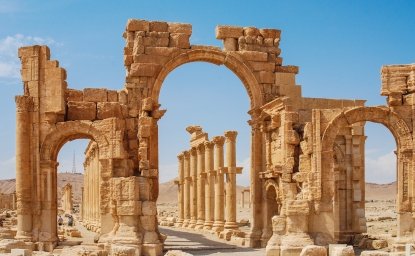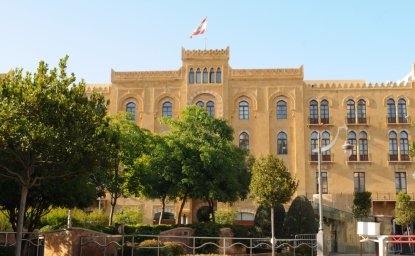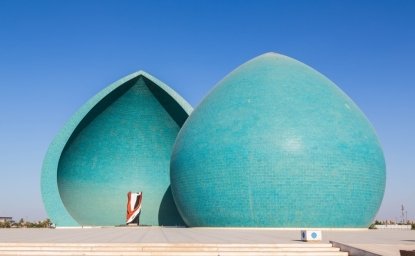This interview has been edited from the version originally recorded for Dialogue, the Woodrow Wilson Center's radio program. It was conducted by Dialogue host and producer, George Liston Seay.
Haleh Esfandiari left Iran in 1978, on the eve of the Islamic revolution. Fourteen years later, she returned to investigate the revolution's impact on the lives of Iranian women. Her book Reconstructed Lives: Women and Iran's Islamic Revolution, published by the Woodrow Wilson Center Press and Johns Hopkins University Press, focuses on interviews with professional women whose careers were either begun or redefined under the Islamic Republic. These interviews reveal how greatly the Islamic regime's women's agenda differed from the agendas of the women involved in the Islamic revolution and illustrate how Iranian women have attempted to live and work in a system that has so dramatically subverted their rights.
In Iran, Esfandiari worked as a journalist and served as an official of the Women's Organization of Iran. Since then, she has taught Persian language at Princeton University and was a Fellow of the Woodrow Wilson Center, where most of Reconstructed Lives was written.
George Liston Seay (GS): The situation of women in Iran as portrayed in Reconstructed Lives provides an arresting story of the plight and strength of Iran's women and of the society they inhabit.
Haleh Esfandiari (HE): The women's movement in Iran started in the late nineteenth century when women came out in the streets during the constitutional revolution; yet after the revolution, they were sent back inside their homes. But not everybody went. A number of women from educated backgrounds remained in the society and began to set up schools for girls, for example, and publish women's journals. These women began a network between Tehran and the provinces, which gradually led to the development of the women's movement.
GS: I do not think it is widely known that Iranian women were that active in their own behalf that early on in this century.
HE: Perhaps because of the general lack of communication between the West and the Middle East, westerners have not been aware of the women's movement in Iran. And it has been a gradual development. The veil was not officially abolished in Iran until 1936, during the era of Reza Shah Pahlavi, the father of modern Iran, and although it had taken everybody outside Iran by surprise, this did not occur in a vacuum. Several years earlier, the shah had been encouraging women to appear in public without the veil or to wear an ordinary scarf rather than the traditional long veil. When the veil was finally abolished officially, it was certainly a victory for women but a tragedy, too, because the right to choose was taken away from women, just as it was during the Islamic Republic when the veil was officially reintroduced in 1979.
GS: You have made a striking point about democracy, about liberty. Choice was lost, and choice is essential to liberty.
HE: My own grandmother refused to leave the house from the day the veil was abolished until Reza Shah left the country. She preferred to stay home. She belonged to an upper class so she had the means and the facilities to stay home and not go out. But ordinary Iranian women who did not have that choice were forced to abandon the veil and go in the streets feeling humiliated and exposed.
GS: Your point is that if Shah Reza had acted more subtly, he would not have set one camp of women against another.
HE: And men against women. But one should also give him credit for other things he did for women. The first university in Iran was set up under him, and from the beginning, males and females had access to that university. And there were minor changes in family law under him that acknowledge the rights of women. These minor changes set the tone for the future.
GS: Most future changes came under the rule of his son, Mohammed Reza Pahlavi, shah from 1941 to 1979 and the man who most vividly comes to mind when Americans think of "the shah of Iran." How much is this shah responsible for the progress of women in Iran? This is also the period in which we began to see an increase in fundamentalist opposition to those liberties?
HE: In the first twenty years of his reign, he really did not at all deal with women's issues. At the same time, there were more women's organizations making their demands public. The country was beginning to turn out larger numbers of educated women than ever before, and these women wanted a change in their legal rights and fuller participation in decisions affecting Iran. Beginning in the sixties, once the shah consolidated his own power, he felt that, for his international standing, it was important to project a progressive image of women in Iran. Women immediately grabbed that opportunity and started pushing for their rights. In 1963, women were given the right to vote and to be elected to parliament, and in the subsequent election, four women were voted into parliament and two to the senate.
GS: In anticipation of the 1979 revolution, women did support Khomeini, and many of them expected that their progress would continue.
HE: The 1979 revolution brought out the masses of Iranian women who were demonstrating for the abolition of the monarchy and for an Islamic republic. They believed that an Islamic republic would give them total equality, removing all existing obstacles for participation of women in the affairs of the state. But in the excitement of that revolution, nobody paid much attention to what Ayatollah Khomeini was saying in Paris. He said women will have a role in the society but within an Islamic framework. Nobody bothered in those days to ask, "What is the Islamic framework?"
GS: You have been quoted as saying that since 1979, the Islamic--or fundamentalist--government's policies toward women have been in "disarray." Is that too strong?
HE: No, that is correct. Over the last seventeen years, the government has been forced to rescind every single law it passed regarding women's rights. The Family Protection Law was suspended immediately after the revolutionaries came to power in 1979. That meant that men once again could divorce their wives and just notify them by mail. Child custody was taken away from women. Men could marry more than one permanent wife and as many temporary wives as they wanted. Men could stop their wives from going out in the street, from working. The progress that women had made during the shah's reign destabilized toward the end. In reaction to the increasingly vocal traditional elements in the society, the shah dramatically stepped back from his support for increased women's involvement in decision-making positions. So women were the first sacrificial lambs of the prerevolutionary movement.
GS: Is it fair to think of this backlash as a harbinger of the complete revocation of women's rights after the revolution?
HE: There was a tendency in Iran leading up to the 1979 revolution for people to take refuge in religion against what many perceived as assaults from the West. In the streets of Tehran in front of cinema houses there were billboards of women in bathing suits. At the seaside, women and men swam together. Some women wore bikinis. Iran is an Islamic country, and this form of westernization was just too much. As a result, a number of the younger generation of women, in particular, began to suggest a return to traditional Islamic dress and to the separation of boys and girls at the universities.
GS: Westernization was advancing too rapidly, too aggressively, and social Iran and religious Iran were upset even as political Iran was pushing the advancement. Yet there has been an increasing need for more educated people in Iran, especially during the war with Iraq.
HE: Yes. The war lasted eight years, and Iran required skilled women to come out and get the jobs done that men were no longer around to do.
GS: The candid voices in your book indicate the unwillingness of Iranian women to retreat. For example, one woman says, "I was a university professor. I was not at all involved in political activities. I watched the excitement of my colleagues, men and women, and I remember the demonstrations, the marches, the gatherings, the discussions on the streets and in the homes. We were all waiting for something to happen."
HE: I remember those days in Iran, too; the revolution created a sense of participation among men and women from all classes. In the marches that led to the revolution, there were professional women without scarves and women from traditional backgrounds wearing the traditional black veil; there were women from lower- and middle-class families with their children. All these women walked shoulder to shoulder, hoping that the revolution would bring for them an improvement in their economic status and an improvement in their social status and most of all an improvement in their legal status.
GS: I was struck by the impressive numbers of professional women among your interview subjects--doctors, lawyers, teachers, artists--and also by what many of them describe as the reality of the revolution.
HE: The women themselves refer to those first years after the revolution as an earthquake. Their husbands--most of whom had lost their jobs--were in a state of depression, and it was left to women to pull the family together: to go out, to get a job, a new job or to continue with their profession despite all the humiliation they were facing.
GS: During the course of the revolution, as women's power was being restricted, men thought they were inheriting it. But the message seems to be how absolute power corrupts. One of the women in the book is quoted as saying, "Since the revolution, men's standing has shrunk in the eyes of women."
HE: This is a typical sentiment among women. Women were brought up in a traditional Islamic society where the man of the house had the ultimate say. Therefore after the revolution, women expected a continuity of the same kind of protection they got from their men before the revolution. But what they were faced with were a bunch of men who withdrew, who had become frightened and depressed after losing their jobs. Women simply took on the roles of man and woman in the home, and the men abdicated their traditional role to them.
GS: Please comment on the election in Iran of Mohammed Khatemi.
HE: Mr. Khatemi would not have been elected president had it not been for the women's vote and the vote of the younger generation, who came out to vote in full force. Women are expecting a lot of changes. They expect female appointments as deputy ministers. They expect a much larger say in the affairs of the state. They expect a drastic improvement in legal rights. They expect an easement on social restriction and harassment, which they face constantly. Women are a vocal group in Iran today. I think Mr. Khatemi will hear what they have to say.
GS: But how do these women reconcile their faith in Islam with their needs and desires as active voices in an Islamic country? Does fundamentalism make a place for these women?
HE: Islam leaves a lot of room for a modern interpretation. Recently women in Iran have become counselors to judges in family courts. There are female Islamists and modern Islamic scholars working on modern interpretations of Islam. In Iran in particular, there are many women familiar with Islamic law and who are introducing a modern interpretation of Islam to the rest of the Islamic world. So the answer to your question is, yes, there is a place—of women's own making—for women in Islam and even in fundamentalism.




